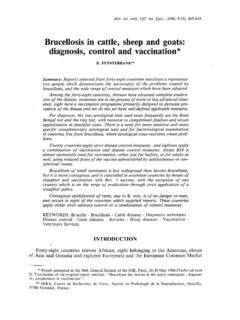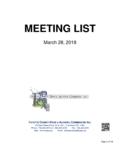Transcription of Co-Occurring Disorders Integrated Dual Disorders Treatment ...
1 Co-Occurring Disorders Integrated dual Disorders Treatment (IDDT). Toolkit Evidence-Based Practices: Shaping Mental Health Services Toward Recovery This document is part of an evidence-based practice implementation resource kit developed through a contract (no. 280-00-8049) from the Substance Abuse and Mental Health Services Administration's (SAMHSA) Center for Mental Health Services (CMHS) and a grant from The Robert Wood Johnson Foundation (RWJF), and support from the West Family Foundation. These materials are in draft form for use in a pilot study.
2 No one may reproduce, reprint, or distribute this publication for a fee without specific authorization from SAMHSA. Co-Occurring Disorders : Integrated . dual Disorders Treatment . Integrated dual diagnosis Treatment is for people who have Co-Occurring Disorders , mental illness and a substance abuse addiction. This Treatment approach helps people recover by offering both mental health and substance abuse services at the same time and in one setting. Table of Contents User's Guide Acknowledgments 3. Foreword 4.
3 Introduction 5. Background 5. Project Philosophy and Values 8. Components of the Integrated dual Disorders Treatment Implementation Resource Kit 9. How to Use the Resource Kit MaterialsAn Implementation Plan 11. A Word About Terminology 14. Phases of the Implementing Evidence-Based Practices Project 15. Annotated Bibliography for Integrated dual Disorders Treatment 15. Special Populations Appendix 28. Selected Articles 31. Information For Consumers 33. Informacin para los Consumidores 36. For Families & Other Supporters 39.
4 Informacin para las Familias y Otros Grupos de Apoyo 42. For Practitioners & Clinical Supervisors 45. For Mental Health Program Leaders 48. Implementation Tips for Mental Health Program Leaders 52. Cultural Competence 57. Fidelity Scale 78. Integrated dual Disorders Treatment Fidelity Scale 78. Using Fidelity Scales for Evidence-Based Practices 110. General Organizational Index 112. Monitoring Client Outcomes 135. 1. USER'S GUIDE. 2. ACKNOWLEDGMENTS. We wish to acknowledge the many people who contributed to the development of the materials on Integrated dual Disorders Treatment for the Implementing Evidence-Based Practices Project: Development Team for the Integrated dual Disorders Treatment Implementation Resource Kit Stephen Baron Paul Gorman Kim T.
5 Mueser John Caswell Pablo Hernandez Fred C. Osher Kevin Curdie Marta Hopkinson Ernest Quimby Michael J. Cohen Lenore Kola Lawrence Rickards Lindy Fox Alan C. McNabb Loralee West Carol Furlong Gary Morse Co-leaders of the Integrated dual Disorders Treatment Development Team Mary Brunette Robert E. Drake David W. Lynde Steering Committee, Implementing Evidence-Based Practices Project, Phase I. Charity R. Appell Howard H. Goldman William C. Torrey Barbara J. Burns Paul Gorman Laura Van Tosh Michael J. Cohen H.
6 Stephen Leff Robert E. Drake Ernest Quimby Project Manager, Implementing Evidence-Based Practices Project, Phase I. Patricia W. Singer 3. FOREWORD. The Substance Abuse and Mental Health Services Administration's (SAMHSA). Center for Mental Health Services (CMHS) is a proud sponsor of this implementation resource kit for Integrated Treatment of dual Disorders . As the federal agency responsible for promoting the quality, availability, and accessibility of services for people with mental illness, CMHS is responsible for identifying treatments for mental illness that work.
7 The materials in this resource kit document the evidence for the effectiveness of Integrated Treatment of dual Disorders and provide detailed information to help communities to implement the practice in real world settings. During development of the implementation resource kit, we placed special emphasis on 1) strengthening the consensus- building process, 2) expanding the involvement of consumers and families, 3). including practical orientation to issues involving service organization and financing, and 4) insisting on paying careful attention to issues of ethnic and cultural sensitivity and overall cultural competence.
8 We are well pleased with the result. Many other organizations contributed to developing this implementation resource kit. This broad coalition of researchers, providers, administrators, policy makers, consumers and family members, gives the resource kit its strength and vitality. We are especially appreciative of the support provided by The Robert Wood Johnson Foundation that sponsored the early stages of the Project, when evidence-based Integrated Treatment of dual Disorders was identified as a practice ready for widespread implementation.
9 We agreed. Substance abuse is the most common and clinically significant comorbid disorder among adults with serious mental illnesses. Research and clinical experience have yielded four basic and consistent findings regarding Co-Occurring psychiatric and substance use Disorders : 1) about 50 percent of people with serious mental Disorders are affected by substance abuse; 2) dual Disorders are associated with increased rates of relapse, violence, incarceration, homelessness, and serious infections such as HIV and hepatitis; 3) most mental health providers are not trained to deliver substance abuse Treatment interventions.
10 And 4) the parallel, but separate, mental health and substance abuse Treatment systems that are common in the United States deliver fragmented and ineffective care for individuals with dual Disorders . This implementation resource kit reflects the current state-of-the-art concerning evidence-based Integrated dual Disorders services. It addresses both the "key ingredients" of the clinical model and many practical considerations essential for successful implementation. It also describes the need for each community to adapt the model to its particular needs and characteristics.















